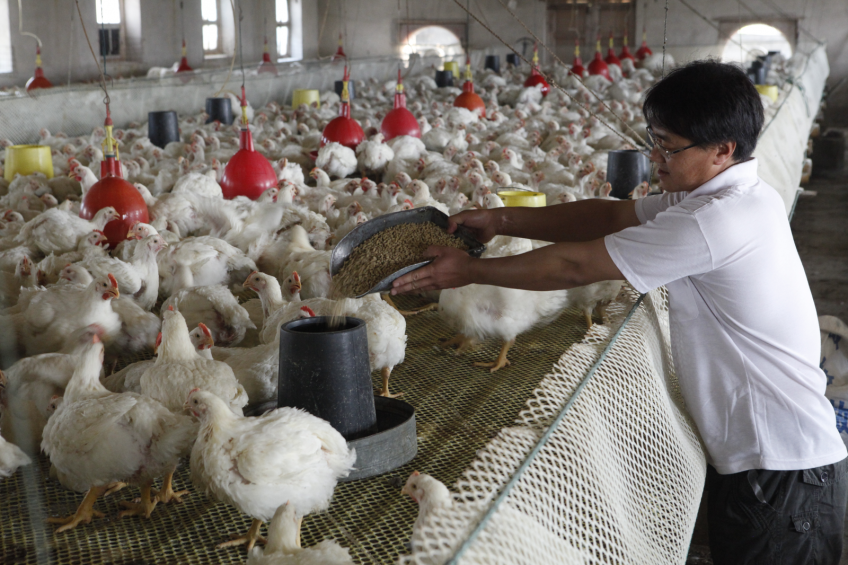Fighting AGP fears with facts in Asia

Antibiotic growth promoters are still commonly used in broiler production on the Asian continent due to fears about profitability losses. Recent Asia-Pacific studies however, have shown the potential of feed additives as a valuable replacement.
Poultry producers, particularly in Asia, are often reluctant to reduce the use of antibiotic growth promoters (AGPs) because of concerns about the likely impact on animal performance and profitability. Two recent studies in this region show that withdrawing AGPs did indeed result in a drop in performance, including decreases of up to 17% (see Figure 1).
However, replacing AGPs with feed additives that support gut health significantly increased overall performance. This is attributed to an enhanced digestion and improved gut stability, both in terms of balanced microbiota and gut wall integrity. These trials were carried out at a University farm in Bogor, Indonesia, and at the Animal Research Farm of Sichuan Agricultural University in China.
In the Indonesian study, the performance of the broilers that were given both types of additive, without any antibiotic growth promoters, was 39% higher than those given AGPs. This is partly thanks to the ability of the additives to reduce the feed conversion ratio (FCR) by 35 points, compared with birds given AGPs (Figure 2).
The Chinese study, which investigated the effects on health, proved that the additives also significantly improved litter quality and footpad quality in broilers. Besides being beneficial to animal welfare, the latter effect was especially relevant in view of the fact that many Chinese people consume chicken feet as a normal part of their diet. In contrast to livestock producers’ expectations, using feed additives as part of good farm management may therefore offer a better strategy for keeping their poultry healthy and profitable than continuing the use of AGPs.
The need to curb antibiotic use
Although it’s generally agreed that the use of AGPs should be reduced, it’s proving difficult to achieve this aim worldwide. Within the EU, AGPs have been banned since 2006. But in most other continents, including Asia, they’re still widely used as a first line of defence against potential performance losses.
AGPs in broilers are mainly given to improve efficiency, as they serve to maintain the health of the gastrointestinal tract. Unfortunately, the widespread use of broad-spectrum AGPs stimulates antimicrobial resistance (AMR) to a far greater extent than single antibiotics used solely for therapeutic purposes.
A recent global study has shown that 25% of antibiotics for humans, and 50% of antibiotics for animals, are used inappropriately. China was already the biggest consumer of antibiotics in 2010, and its usage is expected to double by 2030 (Thomas P. Van Boeckel et al, 2014; 2015). Most of the antibiotics used in China are in fact AGPs. Indonesia has recently shown the largest relative increase in antibiotic consumption, despite wishing to stop the use of AGPs in order to be able to export poultry products to the EU.
Antimicrobial resistance is increasingly responsible for poor performance. Improvements in genetics, housing, management and feed formulation don’t achieve their maximum effect due to antimicrobial resistance. Also, some diseased animals cannot be treated properly any more because therapeutic antibiotics no longer work.
Antimicrobial resistance in animals is also related to resistance in humans. It has been estimated that by 2050, more people will die worldwide from diseases that cannot be treated effectively by antibiotics, than from cancer. Especially for a heavily populated country like China this is a potential threat (Figure 3), and concerns amongst consumers and politicians are both on the rise. The positive results of the animal studies described in this region show that there are economically valid alternatives to the use of AGPs in animal feed.
Figure 3 – Mortality due to AMR per 10,000 of population in 2050 (projection).

Tropical versus temperate environments
In tropical conditions and especially where the housing is still basic, the heat and humidity are much higher than what producers are used to in Europe. Broilers are often kept in open houses where they may be exposed to temperatures of 33°C or more, rather than a standardised temperature schedule, and with high humidity. The Asia-Pacific trials show that switching from AGPs to feed additives provides better results even in very hot and humid conditions.
Functional feed additives have been proven to play an important role in minimising the use of AGPs, in combination with good farm and health management. The two products tested in Asia-Pacific consist of multiple components which work together to produce a greater effect than single additives alone. These kind of additives, used in the drinking water and feed, increase growth performance and decrease the feed conversion ratio. In addition, they can have positive effects on the gut microbiota balance, the gut mucosal barrier and the immunity of the animal. All of this contributes to a healthy animal with good performance within an AGP-free production system, where the only antibiotics used are for therapeutic purposes. Poultry producers can now be shown that it is possible to stop using AGPs without suffering a loss in profitability. By replacing AGPs with feed additives, they can actually make more money, while also reducing the risk of antimicrobial resistance.
Join 31,000+ subscribers
Subscribe to our newsletter to stay updated about all the need-to-know content in the poultry sector, three times a week. Beheer
Beheer











 WP Admin
WP Admin  Bewerk bericht
Bewerk bericht